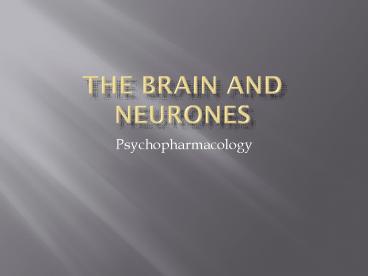The Brain and Neurones - PowerPoint PPT Presentation
Title: The Brain and Neurones
1
The Brain and Neurones
- Psychopharmacology
2
The Human Brain
- Complex
- 1.4 kg in weight
- Pre frontal cortex
- 2 of body weight
- 20 of oxygen
- 15 of our cardiac input
- 10 of all energy
3
The Blood Brain barrier
- Brain protection system
- The BBB is both
- A physical barrier that restricts the entrance of
potentially harmful substances - A system of cellular transport mechanisms that
controls the entrance of essential nutrients
4
Forebrain
- Cerebrum and Cerebral cortex
- Left and Right Hemispheres
- Left Hemisphere- dominant hemisphere
- Production of language
- Mathematical ability
- Problem solving
- Right Hemisphere
- - Creativity
- - Spatial ability
5
(No Transcript)
6
Frontal Lobe
- Located at the front of both cerebral hemispheres
- Primary motor cortex
- Pre motor cortex
- Brocas Area
- Complex Functioning personality, judgement,
insight, reasoning, problem solving, abstract
thinking and working memory
7
Parietal Lobe
- Located behind frontal lobe
- Somatosensory cortex
- Spatial orientation, perception and comprehension
of language function recognising objects by touch - Links visual and somatosensory information
together - Neglect
8
Temporal Lobes
- Located et each side of the brain
- Involved in receiving and processing auditory
information, higher order visual information ,
complex aspects of memory and language - Wernickes area
9
Occipital Lobe
- Visual processing area
- Corpus Callosum
10
Diencephalon
- Thalamus
- Filter for sensory information
- Control of mood states
- Body movement
- Hypothalamus
- Central control
- Regulate autonomic, emotional, endocrine and
somatic function - Stress
11
Hindbrain
- Cerebellum
- Equilibrium
- Muscle tone
- Postural control
- Coordination of muscle movement
- Pons
- Relay station
12
Hindbrain
- Medulla Oblongata
- Skeletal muscles
- Balance
- Coordination
- Inner ear sound impulses
- Heart rate, vomiting, sneezing
- Reticular formation
- Arousal
- Circadian rhythm
- respiration
13
- Basal ganglia
- Muslce tone
- Posture
- Movement
- Substantia Nigra
14
The Limbic System
- Amygdala
- Mood
- Hippocampus
- Memory
15
Neurones
- The structural unit of the brain
- Cell body
- Axon
- Dendrites
- Synapse
16
(No Transcript)
17
Electrical Transmission
- The Information that flows in the neurone
- Approximately 10 billion neurons are responsible
for receiving, organising and transmitting
information in the central nervous system - Ions in the intracellular fluid (inside the
cell) have a negative charge - Ions in extracellular fluid (outside the cell)
have a positive charge attracting positively
charged cells (cations) - Potential difference between the inside and
the outside of the cell
18
19
- Ions are sodium, potassium, calcium and chloride
- voltage gated
- Resting Potential vs. Action potential
20
Chemical Neurotransmission
- The flow of neurotransmitter across the synapse
- Neurotransmitter
- Made in the pre synaptic neurone
- Stored inactively in synaptic vesicles
- Released from the synaptic vesicles into the
synapse - Binds to receptors
- Binds to reuptake transporters to be taken back
into the neurone - Is degraded by specific enzymes
21
(No Transcript)
22
Neurotransmitters
- Acetylcholine (ACh)
- Norepinephrine (NE)( also known as noradrenaline)
- Dopamine(D)
- Serotonin (5HT)
- Glutamate
- Gamma-aminobutyric acid (GABA)
23
Neurotransmitters
- There are two kinds of neurotransmitters
INHIBITORY and EXCITATORY. - stimulate the brain
- calm the brain
24
Acetylcholine (ACh)
- Cholinergic pathways
- thought to be involved in cognition (esp.
memory) and our sleep/wake cycle - parasympathetic nervous system regulating
bodily functions such as heart rate, digestion,
secretion of saliva and bladder function - Alzheimers disease and myathesia gravis
(weakness of skeletal muscles) - Anti-cholinergic effects
25
Norepinephrine (NE)
- attention, alertness and arousal
- NE levels fluctuate with sleep and wakefulness
and changes in attention and vigilance - mood, affective states and anxiety
- antidepressant
26
Dopamine(D)
- complex movement and cognition
- Emotional responses such as euphoria or pleasure
(seen in amphetamine/cocaine use). - Significant role in motor control
- EPSEs
27
Serotonin (5HT)
- Great influences on behaviour.
- Low serotonin activity is associated with
aggression, suicide, impulsive eating and
dis-inhibited sexual behaviour - modulating general activity levels of the CNS,
particularly the onset of sleep - depression and anxiety disorders
- delusions, hallucinations (LSD)
- negative symptoms of schizophrenia
28
Glutamate
- Glutamate is found in all cells of the body
- control the opening of ion channels that allow
calcium to pass into nerve cells producing
impulses - Blocking of glutamate receptors produces ( eg. By
PCP) schizophrenic like symptoms - Over exposure of neurons to glutamate cause cell
death seen in stroke and Huntingtons disease
(PN).
29
Gamma-aminobutyric acid (GABA)
- Inhibitory and its pathways are only found within
the CNS. - control excitatory neurotransmitters in the brain
and controlling spinal and cerebral reflexes. - anxiety disorders
- decreased GABA can lead to seizure activity
- Benzodiazepines and barbiturates sedative
medication act on GABA































